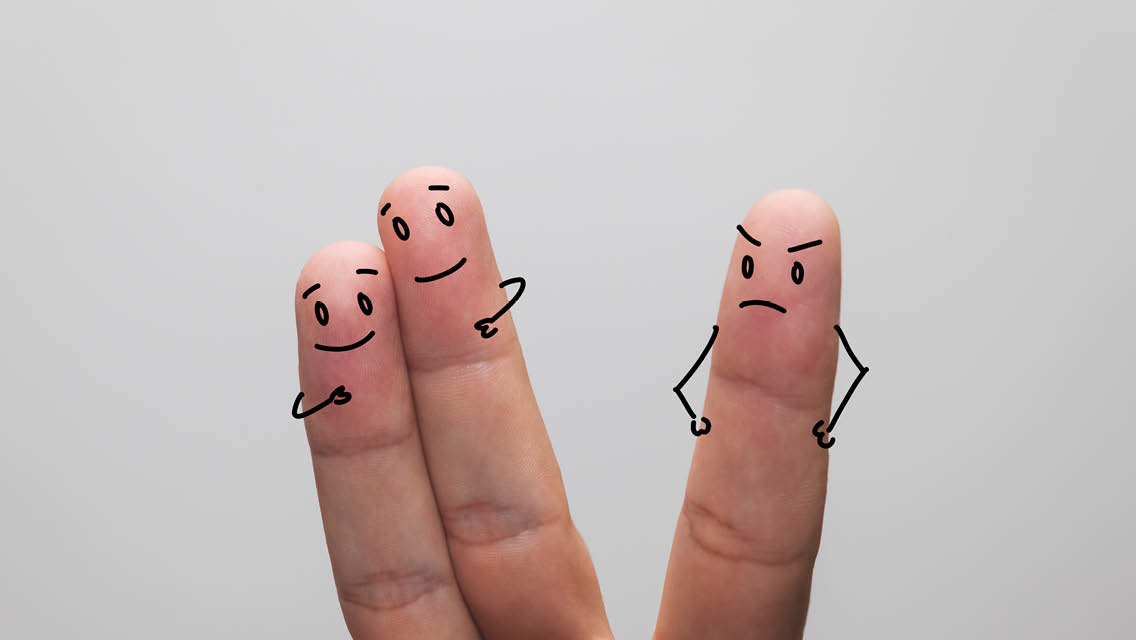Helen Russell’s earliest memory is of the day her baby sister died. Helen was 3 years old.
“We weren’t permitted to talk about it,” she recalls. “It wasn’t acceptable. We were supposed to be cheerful and carry on.”
Her parents split up soon afterward. Then, her father largely disappeared from her life.
Russell, now a journalist, would eventually focus her research on happiness and write two books on the topic. In 2019, during the tour for her book The Atlas of Happiness, she began to notice how many members of the audience would ask her the same question: “How can I be happy?”
This isn’t a strange question in itself, but Russell noticed that it was often coming from people who had recently lost a loved one, or been laid off, or faced health issues. In other words, she says, people who had very good reasons to feel unhappy.
So Russell started asking a different question: “Why is it so difficult to feel so-called negative feelings?”
She shares her findings in her 2021 book, How to Be Sad, where she openly discusses the grief of losing her sister and father, which she’d suppressed for 40 years.
“Many of us have been raised with the assumption that what we don’t talk about can’t hurt us,” Russell says. “For a long time, not talking about being sad was seen as a sign of strength. But really, the opposite is true.”
The Art of Avoidance
Sadness is just one challenging emotion that we might try to avoid. Others include anger, fear, guilt, and shame.
Susan David, PhD, author of Emotional Agility and a psychologist at Harvard Medical School, says “display rules” are one common obstacle standing between us and certain emotions. “Display rules are the implicit rules that exist in a family or in a culture,” she explains. “They basically say either you shouldn’t feel emotions, or that some emotions are OK and some aren’t.”
Display rules also help enforce the idea that certain emotions are acceptable for one group but not another. For example, in some cultures, girls can cry but not show anger; boys can get angry but not cry. Yet she notes that “boys feel emotions the same way as girls. It’s not that they feel more or less.”
If we display emotions that break our culture’s rules, others may judge or even reject us. And if we see others breaking the rules, we might feel repelled without fully understanding why. (For more on David’s work, see “How to Be Emotionally Agile.”)
Feelings don’t particularly care about the rules, of course — they arise even if we do our best to push them back. And all feelings, including difficult ones, have a constructive function, explains Marc Brackett, PhD, founding director of the Yale Center for Emotional Intelligence and author of Permission to Feel.
“When we ignore our feelings or suppress them, they only become stronger.”
“Negative emotions have a constructive function: They help narrow and focus our attention,” he writes. Sadness, anger, and guilt can alert us to what we really care about, reveal when we’re being mistreated, or jolt us into recognizing a mistake.
When we deny, suppress, or avoid emotions, they don’t go away, Brackett adds. “The irony . . . is that when we ignore our feelings or suppress them, they only become stronger,” he notes. “They pile up like a debt that will eventually come due.”
Denying difficult feelings costs us in other ways, too, says Russell. If we attempt to shut down one emotion, we end up stifling them all. “Then we’re not open to joy in the same way, and life in general in the same way.”
Finally, denying difficult feelings means we miss what they’re trying to tell us. “Emotions are data,” David explains. “They are signposts pointing to things that are important to us, to our values.”
In other words, feelings are directions, not directives. Feeling our feelings isn’t the same as acting on them, and becoming more aware of feelings allows us to choose how to respond. Learn what experts have to say about how to cultivate this awareness and make those choices.
Accepting Anger
Because of display rules, many of us have internalized the idea that any show of anger is unacceptable. In the United States, this holds true especially for women and people of color. Yet unexpressed anger often turns into resentment, which is a quick route to soured connections.
Resentment increases the risk of what David calls “emotional leakage,” such as smothered anger that comes out in a snide comment; this is one way repressed anger harms relationships.
“Love, connection, vulnerability, and emotions are the relational glue,” she says. “If you start thinking, I’m angry with this person, but I’m just not going to say anything because I’m not allowed to feel this, then you’re still feeling angry but you’re not bringing that anger in a constructive and effective way to the relationship.”
When we shrink our anger to fit what we think a relationship can handle, what we think we deserve, or what we think we’re allowed to feel, we’re cutting ourselves off from the chance to repair issues that need attention.
“When you take the time to accurately name your emotion, you reduce it to a finite experience with boundaries.”
But when we accept and express anger constructively, it becomes a tool that allows us to address injustices and attend to unmet needs. (For more on the power of anger, see “The Upside of Anger.“)
For many of us, learning to express anger can be scary: We might fear that once we open the floodgates, everything will come tumbling out and we’ll lose control. Yet consciously choosing to accept our anger gives us other choices. We can decide when, how, and to whom we will express it. (See “Healthy Emotional Expression” further down.)
When you notice you’re feeling anger, David says, first create some distance between yourself and the feeling, which is different from burying or denying it.
She recommends these steps:
- Name your anger precisely, even if you’re speaking only to yourself. Other feelings can fall under the umbrella of anger, she says: You might observe that you’re frustrated, grumpy, annoyed, defensive, irritated, disgusted, offended, or spiteful. “When you take the time to accurately name your emotion, you reduce it to a finite experience with boundaries.”
- Put space between yourself and your anger linguistically, shifting from “I am angry” to “I feel angry” (or frustrated, irritated, or defensive). “When you say, ‘I am angry,’ what you’re saying is that all of me, 100 percent of me, is defined by anger,” David explains. But we are always more than just one feeling.
- Take a break — even if it’s just three deep breaths — to witness your angry feelings before you express or act on them. This allows you to shift from feeling flooded by anger to observing it. “You open the door to it and to what it suggests,” she says. “But you’re not letting the emotion run the show.”
Allowing Sadness
Not all cultures have prohibitions on sadness. “I think we all assume that what we grew up with is the only way,” says Russell. “But actually, I think the U.K. and the United States are outliers in the desire to avoid sadness.”
For example, she notes that there’s no equivalent English term for the Chinese idea of xingfu, which expresses the notion that a good life may contain pain and difficulty as well as happiness and joy. And Russell found that displaying sadness is considered OK in East Asian cultures.
Similarly, there’s no English equivalent of the Portuguese word saudade — the bliss of melancholy, where one savors the memory of bygone happiness or feels nostalgic for something that never happened.
Being able to face sadness and grief can help us learn to live with those experiences, and then we don’t have to spend our lives running from them.
Periods of sadness can even improve our emotional and relational health. University of New South Wales researchers discovered that study participants in negative mood states displayed improved memory and greater motivation. Other studies have found that sadness may improve judgment and, in some cases, make us more generous and enhance our communication.
When Russell was finally ready to explore her decades-buried grief with a therapist, she felt freed. “I had to sit with that sadness,” she recalls. “It was painful, and it was uncomfortable, but riding that wave is hugely liberating.”
In the United States, expressing sadness can cause others to shy away. Americans prize optimism, so most of us don’t learn how to be comfortable with sadness in others or in ourselves. But no one is immune to loss and difficulty. Being able to face sadness and grief can help us learn to live with those experiences, and then we don’t have to spend our lives running from them.
Russell suggests the following practices:
- Permit yourself to feel sadness. This can be the hardest part, so ease into this by first admitting your feelings to yourself. “I feel sad” is a good place to start.
- Make time for sadness. This emotion asks us to slow down. You may be less productive and feel less social for a time. That’s OK.
- Seek comfort but try to avoid deprivation and excess. Offer yourself small comforts; this can make it easier to resist impulsive choices.
- Talk to someone. Be it a therapist, friend, mentor, or faith leader, seek out someone who can listen without judgment and without interrupting.
Facing Fear
Fear can connect us to our vulnerabilities, which can be deeply uncomfortable — especially if you’re someone who thinks of yourself as strong, says clinical psychologist Molly Howes, PhD. Fear can make us feel weaker or smaller than somebody else.
To defend ourselves, Howes notes, we may react with anger instead, “even when what [we] initially felt was a more vulnerable feeling, like fear or hurt.” In many cultures, anger is simply a more acceptable emotion than fear — especially for men.
Still, as in many myths and stories, naming a monster reduces its power. And naming fear, Howes says, reduces its power in a specific way.
“Words are formed in the neocortex,” she explains. This part of the brain houses executive functions — conscious, complex decisions. Fear, meanwhile, springs from the amygdala, located in our deep, reptilian brain, which is involved in the processing of threatening stimuli.
Expressing fear to someone builds trust and creates and fosters a greater intimacy.
Identifying a feeling can build a connection between the two areas, which allows us to have more choices about how to respond when we’re afraid.
Howes says that naming fear can give us more flexibility and make us more relational. “It lessens the control that the feeling can exert over you.”
Sharing fears with others does involve vulnerability and openness, but that is partly the point, she suggests. Expressing fear to someone builds trust and creates and fosters a greater intimacy.
These are some ways to face your fear more directly:
- Name the feeling. As with anger, you can start by naming it to yourself. This can prevent you from quelling vulnerable feelings. Potential starter phrases include “I’m feeling afraid right now. I’m feeling scared of ___.” Or, if you’re speaking to another person, you could say, “This situation scares me. Can I discuss it with you?”
- Review your situation. Fear is an important survival impulse. Are you in actual danger? If so, how can you respond? Fear is like a fire alarm: There’s not always fire when it goes off, but when there is, the alarm may help save you.
- Practice sharing your fears with someone close to you. Choose a few trusted confidants with whom you can discuss what feels scary. As you get used to talking about your fears, you may find they have less of a hold on you. If you’re in an intimate relationship where you don’t feel comfortable sharing your fears, counseling might be another solution.
Making Peace With Guilt and Shame
While guilt and shame may appear similar, there are important distinctions between them. “Guilt can be feeling bad about something you’ve done, and shame is feeling bad about who you are,” says Howes.
Guilt can be productive, she adds. “It can drive people to take constructive and corrective action.”
If we are relatively secure, we feel guilt when it’s appropriate. This feeling enables us to identify our mistakes, take ownership of them, and let them go.
But if we feel too insecure to admit mistakes and take responsibility for them, this insecurity can lead directly to shame — and this feeling can be paralyzing.
“Guilt can be feeling bad about something you’ve done, and shame is feeling bad about who you are.”
Renowned author and researcher Brené Brown, PhD, notes that shame signals “the fear of disconnection.” When we feel shame, we often believe that we’ve done or failed to do something so important that it’s made us unworthy of connecting with others; we don’t belong — and don’t deserve to.
Shame may also signal that we’re placing an excessive value on our performance — a key sign of perfectionism. In her 2021 book, Atlas of the Heart, Brown calls shame “the birthplace of perfectionism.”
“Healthy striving is internally driven,” she explains. “Perfectionism is externally driven by a simple but potentially all-consuming question: What will people think?”
Because shame is so painful, it may be the emotion we’re most likely to avoid. Yet when we run from or bury feelings of shame, we’re likely to act out in other ways — often by aggressively trying to gain power over others or, conversely, by people-pleasing and approval-seeking.
The solution, Brown suggests, is to embrace vulnerability, which can help us develop “shame resilience.”
She identifies these steps:
- Recognize, name, and understand your shame triggers.
- Identify the messages and expectations that stimulate a shame response in you, and ask yourself whether they are realistic and attainable.
- Connect with others to receive and offer empathy.
- Share openly about feelings of shame with people you trust.
One thing all difficult emotions have in common is that they are unavoidable. Sooner or later, we’re going to get angry, feel sad, or make a mistake and feel guilt — or even shame.
Yet another thing these emotions share is that they can all help us grow.
So don’t worry too much about being perfect with them. Just start where you are, feeling what you feel and doing the best you can to accept it. That will always be good enough.
Healthy Emotional Expression
Emotional honesty is not the same as being run by your emotions.
In his book Permission to Feel, Marc Brackett, PhD, founding director of the Yale Center for Emotional Intelligence, notes that many people believe that “‘permission to feel’ means license to let it all hang out, to whine, yell, act on every emotional impulse, and behave as though we have no control over what we feel.”
Yet healthy emotional expression relies on regulation — feeling emotions without allowing them to take us over.
It also means we assume responsibility for our emotions rather than blasting them at others. Attacking other people or dumping feelings on them in the name of emotional honesty is harmful.
Responsibly expressing our feelings is not the same as stifling them, Brackett emphasizes. Rather, it’s choosing “the right expression with the right audience, in the right place, and at the right time.” He suggests asking yourself these questions to determine how best to express your feelings in the moment:
- Where am I? Am I at home, where it’s safe to be vulnerable? At work, where I have professional boundaries to consider? At a party? At a funeral?
- Who am I with? Friends? Loved ones? Colleagues? Acquaintances? Strangers?
- What’s my goal in this situation? To get support? To express a grievance? To offer an honest reaction?
- With this knowledge, what’s the most helpful way to show my emotions? Specifically, how much of this feeling do I want to share, and how much do I want to withhold?
Emotional Literacy for Kids
We aren’t born knowing how to manage our emotions; it’s a skill we develop throughout life. And today many educators — from preschool to high school — have begun to create curriculum to teach students how to recognize and regulate their feelings.
One such program was created by Marc Brackett, PhD — a professor at Yale University’s Child Study Center — and a team at the Yale Center for Emotional Intelligence. It’s called Ruler, which stands for the following:
- Recognizing emotions in oneself and others
- Understanding the causes and consequences of emotions
- Labeling emotions with nuanced vocabulary
- Expressing emotions in accordance with cultural norms and social context
- Regulating emotions with helpful strategies
Students can use it as shorthand when they’re flooded by feelings at school.
The success of the program reveals the value of early education in emotional literacy. Over the past two decades, Brackett has observed Ruler’s positive impact on students’ “emotional-intelligence skills, social problem-solving ability, work habits, and grades; on classroom and school climate, including fewer instances of bullying; and on teacher stress, burnout, and instructional support for students.”
And if the effects of developing emotional literacy are that positive for children, it’s safe to assume the practice is good for adults, too.
This article originally appeared as “Hard Feelings” in the April 2023 issue of Experience Life.






This Post Has 0 Comments